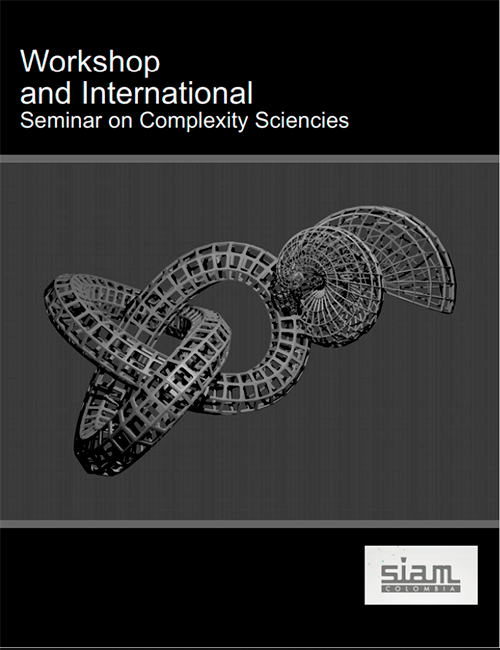Publicado
Epidemiology, public health and complex networks
Aguilar-Palacio, I., Carrera-Lasfuentes, P., & Rabanaque, M. J. (2015). Youth unemployment and economic recession in Spain: influence on health and lifestyles in young people (16–24 years old). International journal of public health, 60(4), 427-435.
Akresh, R., Lucchetti, L., & Thirumurthy, H. (2012). Wars and child health: Evidence from the Eritrean-Ethiopian conflict. Journal of Development Economics, 99(2), 330–340. http://doi.org/10.1016/j.jdeveco.2012.04.001
Al-Qudsi, S. S. (2000). Profiles of refugee and non-refugee Palestinians from the West Bank and Gaza. International Migration (Geneva, Switzerland), 38(4), 79–107.
Anand, K., & Bianconi, G. (2009). Entropy measures for networks: Toward an information theory of complex topologies. Physical Review E, 80(4), 045102.
Audet, Mélisa, et al. (2017). Lifestyle Inequalities: Explaining Socioeconomic Differences in Preventive Practices of Clinically Overweight Women After Menopause. Qualitative Health Research, vol. 27, no 10, p. 1541-1552.
Balcan, D., Colizza, V., Gonçalves, B., Hu, H., Ramasco, J. J., & Vespignani, A. (2009). Multiscale mobility networks and the spatial spreading of infectious diseases. Proceedings of the National Academy of Sciences, 106(51), 21484- 21489.
Barabási, A. L., & Albert, R. (1999). Emergence of scaling in random networks. science, 286(5439), 509-512.
Brauer, F., Castillo-Chavez, C., Mubayi, A., & Towers, S. (2016). Some models for epidemics of vector-transmitted diseases. Infectious Disease Modelling, 1(1), 79-87.
Bichara, D., & Castillo-Chavez, C. (2016). Vector-borne diseases models with residence times–a lagrangian perspective. Mathematical biosciences, 281, 128-138.
Blattman, C., & Miguel, E. (2010). Civil War. Journal of Economic Literature, 48(1), 3–57.
http://doi.org/10.1016/S1574-0013(06)02023-0
Bilak, A., Caterina, M., Charron, G., Crozet, S., et al. (2015) Global overview 2015: people internally displaced by conflict and violence. Internal Displacement Monitoring Centre, Norwegian Refugee Council.
Brinton, E. A. (2016). Management of hypertriglyceridemia for prevention of atherosclerotic cardiovascular disease. Endocrinology and metabolism clinics of North America, 45(1), 185-204.
Brown, David R.; Brewster, Luther G. (2015). The food environment is a complex social network. Social Science & Medicine, vol. 133, p. 202-204.
Brungborg, H., Tabeau, E., & Urdal, H. (2006). The Demography of Armed Conflict. Springer.
Brungborg, H., & Urdal, H. (2005). The Demography of Conflict and Violence: An Introduction. Journal of Peace Research, 42(4), 371–374. http://doi.org/10.1177/0022343389026001001 17
Bundervoet, T., Verwimp, P., & Akresh, R. (2008). Health and Civil War in Rural Burundi. Journal of Human Resources, 44(2), 536–563. http://doi.org/10.3368/jhr.44.2.536
Castillo-Chavez, C., Bichara, D., & Morin, B. R. (2016). Perspectives on the role of mobility, behavior, and time scales in the spread of diseases. Proceedings of the National Academy of Sciences, 113(51), 14582-14588.
Co, J., Jeffrey, J., Emmett, M., Modak, A., & Sondike, S. B. (2015). Obesity, hypertension and metabolic syndrome in children in West Virginia. The West Virginia medical journal, 111(4), 20.
De Azevedo Barros, Marilisa Berti, et al. (2016). Social inequalities in health behaviors among Brazilian adults: National Health Survey, 2013. International journal for equity in health, vol. 15, no 1, p. 148.
Delmas, E., Besson, M., Brice, M. H., Burkle, L., Dalla Riva, G. V., Fortin, M. J., ... & Olesen, J. M. (2017). Analyzing ecological networks of species interactions. bioRxiv, 112540.
Doocy, S., Lyles, E., Roberton, T., Akhu-Zaheya, L., Oweis, A., & Burnham, G. (2015a). Prevalence and care-seeking for chronic diseases among Syrian refugees in Jordan. BMC Public Health, 15(1), 1097.
Doocy, S., Lyles, E., Delbiso, T. D., & Robinson, C. W. (2015b). Internal displacement and the Syrian crisis: an analysis of trends from 2011– 2014. Conflict and health, 9(1), 33.
Dorogovtsev, S., & Mendes, J. (2003). Evolution of Networks: From Biological Networks to the Internet and WWW Oxford: Oxford Univ.
Estrada, E., & Rodriguez-Velazquez, J. A. (2005). Subgraph centrality in complex networks. Physical Review E, 71(5), 056103.
Fortunato, S. (2010). Community detection in graphs. Physics reports, 486(3), 75-174.
Furukawa, S., Fujita, T., Shimabukuro, M., Iwaki, M., Yamada, Y., et al. (2017). Increased oxidative stress in obesity and its impact on metabolic syndrome. The Journal of clinical investigation, 114(12), 1752- 1761. 18
Franco, Saúl, et al. (2006). The effects of the armed conflict on the life and health in Colombia. Ciência & Saúde Coletiva, vol. 11, p. 1247-1258.
Green, S., Şerban, M., Scholl, R., Jones, N., Brigandt, I., & Bechtel, W. (2017). Network analyses in systems biology: new strategies for dealing with biological complexity. Synthese, 1-27.
Inoue, M. (2017). Changing epidemiology of Helicobacter pylori in Japan. Gastric Cancer, 1-5.
Iqbal, Z. (2010). War and the Health of Nations. Stanford University Press.
Kalipeni, E; Oppong, J. (1998) The refugee crisis in Africa and implications for health and disease: a political ecology approach. Social Science & Medicine, 1998, vol. 46, no 12, p. 1637-1653.
Keely, Reed, and Waldman. 2001. “Understanding Mortality Patterns in Complex Humanitarian Emergencies”. In NRC (eds.) Forced Migration and Mortality. National Academy Press
Kumpula, J. M., Kivelä, M., Kaski, K., & Saramäki, J. (2008). Sequential algorithm for fast clique percolation. Physical Review E, 78(2), 026109.
Marmot, M. (2005). Social determinants of health inequalities. The Lancet, 365(9464), 1099-1104.
Milo, R., Shen-Orr, S., Itzkovitz, S., Kashtan, N., Chklovskii, D., & Alon, U. (2002). Network motifs: simple building blocks of complex networks. Science, 298(5594), 824-827.
Ministerio de Salud (2017). Modelo Integral de Atención de Salud “MIAS”, Url:https://www.minsalud.gov.co/Paginas/presentaciones-modelo-integralatencion-salud-mias.aspx.
Moran, W. P., Zhang, J., Gebregziabher, M., Brownfield, E. L., Davis, K. S., et al. (2017). Chaos to complexity: leveling the playing field for measuring value in primary care. Journal of evaluation in clinical practice, 23(2), 430-438.
Newman, M. (2010). Networks: an introduction. Oxford university press. NRC- National Research Council. 2001. Forced Migration and Mortality. National Academy Press 19
Ohlsson, B., Orho-Melander, M., & Nilsson, P. M. (2017). Higher Levels of Serum Zonulin May Rather Be Associated with Increased Risk of Obesity and Hyperlipidemia, Than with Gastrointestinal Symptoms or Disease Manifestations. International journal of molecular sciences, 18(3), 582.
Onnela, J., J. Saramäki, J. Kertész, K. Kaski. (2005). Intensity and coherence of motifs in weighted complex networks. Phys. Rev. E 71(6), 065103.1–065103.4.
Palla, G., Derényi, I., Farkas, I., & Vicsek, T. (2005). Uncovering the overlapping community structure of complex networks in nature and society. arXiv preprint physics/0506133.
Pastor-Satorras, R., & Vespignani, A. (2002). Immunization of complex networks. Physical Review E, 65(3), 036104.
Personhood, C., Chronic, R. W., Home, I., Guideline, H., Rousseau, H., & Water, P. (2014). Self-management of Hypertension in High-Risk Patients 799.
Powers, M. A., Bardsley, J., Cypress, M., Duker, P., Funnell, M. M., et al. (2017). Diabetes self-management education and support in type 2 diabetes: a joint position statement of the American Diabetes Association, the American Association of Diabetes Educators, and the Academy of Nutrition and Dietetics. The Diabetes Educator, 43(1), 40-53.
Reconciliacion Colombia. 2015. Los desplazados son más pobres que el resto de la población, 16 February 2015, available at: http://goo.gl/eK5F38
Retterstøl, K., Narverud, I., Selmer, R., Berge, K. E., Osnes, I. V., et al. (2017). Severe hypertriglyceridemia in Norway: prevalence, clinical and genetic characteristics. Lipids in Health and Disease, 16(1), 115.
RNI (2017). Registro Nacional de Información. Url:https://rni.unidadvictimas.gov.co/RUV, Consultado: 05-06-2017.
Rodríguez‐Rodríguez, M. C., Jordano, P., & Valido, A. (2017). Functional consequences of plant‐animal interactions along the mutualism‐antagonism gradient. Ecology, 98(5), 1266-1276.
Smoly, I. Y., Lerman, E., Ziv-Ukelson, M., & Yeger-Lotem, E. (2017). MotifNet: a web-server for network motif analysis. Bioinformatics, 33(12), 1907-1909.
Sobel, M. E. (2013). Lifestyle and social structure: Concepts, definitions, analyses. Elsevier.
Strogatz, S. H. (2001). Exploring complex networks. nature, 410(6825), 268.
Taimeh, Z., Duprez, D., & Garry, D. J. (2017). Heart Failure Prevention. In Congestive Heart Failure and Cardiac Transplantation (pp. 267-284). Springer International Publishing.
Torche, F., & Villarreal, A. (2014). Prenatal Exposure to Violence and Birth Weight in Mexico: Selectivity, Exposure, and Behavioral Responses. American Sociological Review, 79(5), 966–992. http://doi.org/10.1177/0003122414544733
Towers, S., Brauer, F., Castillo-Chavez, C., Falconar, A. K., Mubayi, A., & Romero-Vivas, C. M. (2016). Estimate of the reproduction number of the 2015 Zika virus outbreak in Barranquilla, Colombia, and estimation of the relative role of sexual transmission. Epidemics, 17, 50-55.
Turel, O., Romashkin, A., & Morrison, K. M. (2016). Health outcomes of information system use lifestyles among adolescents: Videogame addiction, sleep curtailment and cardio-metabolic deficiencies. PloS one, 11(5), e0154764.
United Nations High Commissioner for Refugees-UNHCR. 2015. UNHCR country operations profile – Colombia, available at: http://goo.gl/2a7r1S, downloaded on 26 March 2015
Urdal, H., & Che, C. P. (2013). War and Gender Inequalities in Health: The Impact of Armed Conflict on Fertility and Maternal Mortality. International Interactions, 39(4), 489–510. http://doi.org/10.1080/03050629.2013.805133
Urdinola, B. Piedad, Torres Avilés, Francisco, & Velasco, Jairo Alexander. (2017). The Homicide Atlas in Colombia: Contagion and Under-Registration for Small Areas.
Cuadernos de Geografía - Revista Colombiana de Geografía, 26(1), 101-118. https://dx.doi.org/10.15446/rcdg.v26n1.55429 • Urdinola, B. P. (2004).Could Political Violence Affect Infant Mortality? The Colombian Case. Coyuntura Social (31), 63-79.
Urdinola, B. P. (2001). Forced Migration: The Case of Internally Displaced Population in Colombia. Les Cahiers Alhim, 3. 21
Varan, B., Tokel, K., & Yilmaz, G. (1999). Malnutrition and growth failure in cyanotic and acyanotic congenital heart disease with and without pulmonary hypertension. Archives of Disease in Childhood, 81(1), 49-52.
Verwimp, P., & Van Bavel, J. (2005). Child survival and fertility of refugees in Rwanda. European Journal of Population, 21(2–3), 271–290. http://doi.org/10.1007/s10680-005-6856-1
Vyhrystyuk, M. S., Rogozhnikova, T. P., Semenova, G. I., Shusharina, I. A., Savelyeva, E. A., & Kunygina, O. V. (2017). The Evolution of the Concept of Public Health in Modern Youth Discourse. Pertanika Journal of Social Sciences & Humanities, 25.
World Health Organization (WHO) (2002). World Report on Violence and Health. Edited by E.G. Krug, L.L. Dahlberg, J.A. Mercy, A. B. Zwi and R. Lozano. WHO, Geneva
Xu, Y., Niu, Y., Gao, Y., Wang, F., Qin, W., et al (2017). Borapetoside E, a Clerodane Diterpenoid Extracted from Tinospora crispa, Improves Hyperglycemia and Hyperlipidemia in High-Fat-Diet-Induced Type 2 Diabetes Mice. Journal of Natural Products.
Zuin, M., Caserta, C., Romanò, L., Mele, A., Zanetti, A., Cannatelli, R., & Battezzati, P. M. (2017). Seroepidemiology of HEV and HAV in two populations with different socio-economic levels and hygienic/sanitary conditions. European Journal of Clinical Microbiology & Infectious Diseases, 36(3), 479-485.



